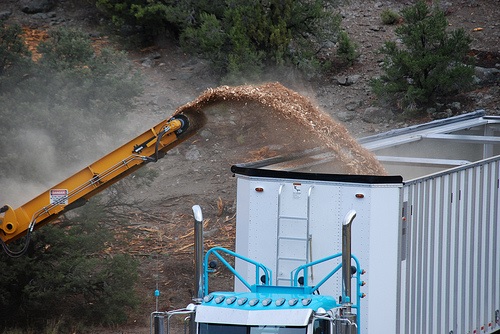
Agricultural News
USDA Economist Finds Wood Pellet Industry Helps Forests, Environment, Economy
Tue, 09 Jun 2015 14:52:57 CDT
 Recently, a university study confirmed that wood pellet production can lead to a reduction in greenhouse gas emissions, increase forest growth, and create jobs. Researchers found that increasing demand for wood pellets resulted in more forest area, more forest investment, large greenhouse gas reductions, and little change in forest carbon inventories.
Recently, a university study confirmed that wood pellet production can lead to a reduction in greenhouse gas emissions, increase forest growth, and create jobs. Researchers found that increasing demand for wood pellets resulted in more forest area, more forest investment, large greenhouse gas reductions, and little change in forest carbon inventories.
Acting USDA Chief Economist Robert Johansson comments on the report and the findings: An industry that can reduce greenhouse gas emissions, increase forest growth, and create jobs sounds too good to be true. But that is the reality of the emerging wood pellets market in the Southern U.S. That conclusion is supported by independent economic assessments of wood bioenergy, including a recent study that specifically focused on European pellet demand conducted by researchers at Duke and North Carolina State Universities. Those researchers found that increasing demand for wood pellets resulted in more forest area, more forest investment, large greenhouse gas reductions, and little change in forest carbon inventories.
So, why is there concern?
Some critics have recently argued that land used to produce biomass for energy should instead be permanently protected as forests. They say that harvesting biomass from forests reduces forest carbon stocks. Instead, they claim that the best way to increase carbon storage is to reduce demand for renewable products that come from the land.
Those arguments fail to account for market dynamics and incentives, and do not recognize that these resources are renewable. Importantly, forests with little or no economic value are at greater risk for conversion to non-forest other uses.
A key to accelerating forest growth and regeneration is to create strong markets for biomass that will stimulate investments. Farmers and forest land owners, as with all business owners, respond to markets and invest in strategies to produce more and earn more when facing increasing demand.
Biomass energy markets are providing greenhouse gas benefits for Europe and can be a larger part of our domestic strategy as well. The United States has committed to lowering greenhouse gas emissions by 26 to 28 percent over the next 10 years. One component of that strategy could be to expand renewable energy generation from forest and agricultural biomass.
The conclusions by the Duke and NC State researchers are not unique to the South. Other studies have found that expanding the use of sustainably grown biomass for electricity production across the U.S. can actually increase forest acreage and carbon storage. Those studies show that as demand for biomass expands, the resource becomes more valuable at creating an incentive to grow and invest. Expanding the use of biomass for electric power will not result in the devastation of the American forests. Rather, forest owners will more effectively and intensively manage forests to increase their value and optimize biomass production and use over time.
For example, USDA Forest Service researchers analyzed the potential effects of greatly expanding biomass electricity markets in the US. They found meeting 8 percent of U.S. electricity production from wood energy would require a 42 percent increase in harvesting; but they also found that a substantial portion of that increase would be offset over 50 years largely because of regrowth and market responses in land use and management strategies. They estimated that substituting biomass for fossil fuels to generate electricity could reduce greenhouse gas emissions by between 40 and 70 percent.
Larger trees and higher valued materials such as sawtimber, are not likely to be used for energy. They are simply too valuable for uses such as structural building material, furniture, high end plywood, and veneer. In reality, new markets for biomass energy can help supplement declining markets for low-value, small diameter wood, logging residuals, and the byproducts of manufacturing. In many parts of the country, wood energy can in turn help to reduce the risks of catastrophic wildfire and provide incentives for forest management needed to address the increased risks of insects and disease.
A great deal is at stake. The nation's forests provide us with many services. They filter the air we breathe, they provide millions of Americans with clean drinking water, they provide habitat and recreation opportunities and they offset about 13 percent of U.S. greenhouse gas emissions each year. Yet many of those services are at risk, in part due to the challenges of a changing climate: increased exposure to pests, diseases, and wildfire. Over the next few decades holding policies constant, carbon sequestration rates in our nation's forests are expected to slow, mainly due to a loss of area principally to development.
Generating clean and renewable energy from biomass is an important and economic tool in our toolkit to address those challenges. Markets work. Increasing forest productivity and health makes them more valuable and less susceptible to conversion to other uses. Vibrant markets for wood materials raise the value of forest lands and encourage investment, regrowth and expansion. Using biomass for energy helps reduce greenhouse gas emissions by displacing fossil energy sources.
A healthy, productive, well-managed forest has high value, not just to the public and to the environment, but to the owner. Shaping policies that recognize the real benefits of biomass and that provide incentives for continued performance improvements is a challenge, but the economic and environmental benefits that will be realized make this worth the effort.
WebReadyTM Powered by WireReady® NSI
Top Agricultural News
More Headlines...



















